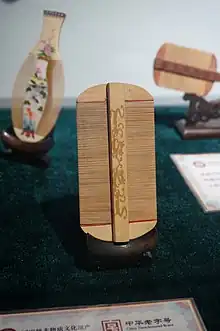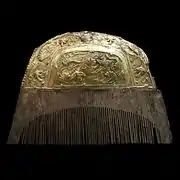.jpg.webp)
Shubi (Chinese: 梳篦), also called as zhi (Chinese: 栉), is a generic term used for Chinese combs in China, which includes thick-teeth comb shu (Chinese: 梳) and thin-teeth comb bi (Chinese: 篦).[1][2][3] Shubi originated about 6000 years ago in China during the late Neolithic period.[4][5] Some Chinese combs dating from the Shang dynasty were found in the Tomb of Fuhao.[6] In ancient China, Chinese combs had a high special status, a high artistic value, was an important form of hair ornament in Chinese history.[7][4] Chinese comb also had and continues to hold unique cultural meaning and emotional value.[8] Chinese combs in China were not used only for grooming purposes, they were also used holding and decorating hair.[9][4] Both Chinese men and women wore decorative combs in their hair in ancient China.[9] Chinese women often wore combs and fine-tooth combs in their hair buns.[7] Chinese comb-making was also an important form of traditional Chinese art and business industry.[9]
Terminology
The term shubi (Chinese: 梳篦) also includes to two types of combs: shu (Chinese: 梳; also lit. translated as comb, and sometimes also refer to coarse and thick-teeth comb) and bi (Chinese: 篦; a type of fine-tooth comb).[1][2][3] The term shubi also refers to a form of hairstyle in ancient China.[1]
The usage of the term zhi (Chinese: 栉) has relatively unstable. The use of the term zhi to refer both types of combs; i.e. thick-tooth combs and fine-teeth combs were only found in the pre-Qin dynasty literature.[3] However, the term zhi was partly changed by the word shu (Chinese: 梳) to refer to thick-tooth comb in the Sui and Tang dynasties.[3] The term zhi was partly changed again by the word bi (Chinese: 篦) to only refer to thin-tooth combs after the Yuan dynasty.[3]
Origin
Invention of comb
According to a legend, the Chinese comb was invented by one of the concubine of the Yellow Emperor, called Fang Leishi (Chinese: 方雷氏).[10]
Invention of Bi
The invention of bi, the fine-tooth comb, is attributed to a Spring and Autumn Period official called Chen Qizi who was put into prison after being found guilty.[1] In prison, Chen Qizi developed lice on his head which made him itched intolerably.[1] After being tortured by the prison wardens with bamboo planks, Chen Qizi discovered that the bamboo planks would be split into strips; he then packed these wooden strips together to create the original fine-toothed comb to clean his hair away from lice and dirt.[1]
Foundation of Comb trade
According to a legend, after the defeat of Chiyou, the craftsman Hao Lian, who knew how to make combs, was captured, imprisoned and given the death sentence.[1] The prison warden, Huang Fu, discovered that Hao Lian could make combs and advised him to make a comb to save his life overnight.[1] The comb made by Hao Lian was presented to the Queen Luo Zu, but Hao Lian was already executed before an amnesty could be issued.[1] After Hao Lian's death, Emperor Xuan Yuan appointed Huang Fu to lead other craftsmen in comb-making based on the models left behind by Hao Lian.[1] Since this time, Hao Lian and Huang Fu have been both considered as the founders of comb trade.[1]
Connotation and significance
Symbolism
Wedding dowry
Chinese combs were also an essential component of dowry in ancient China; they are also a symbolism of a happy life.[11]
Pre-wedding ceremony
Prenuptial hair-combing ceremony, also known as shang tou (Chinese: 上头), is a traditional Cantonese Chinese ritual which takes place on the eve of the wedding by the couples.[12] It is held at a time which is considered auspicious at the homes of groom and bride respectively to symbolize a rite of passage.[12] This practice is still performed in some ethnic groups in Singapore.[12] It is believed to have been introduced in Singapore by the Cantonese.[13]
Taboo
Combs in some Chinese nationalities are considered a kind of taboo; for example, for the Tibetans, combs must be hidden in private places, people who wore combs in their hair were perceived as being impolite.[11]
Item of special status
Gift to other leaders
In the Han dynasty, Emperor Wendi gave combs to the leader of the Xiongnu, Maodun.[6]
Special rights of business
Chinese comb-making was an important form of business industry in ancient China.[9] People who were in the business of the selling or the making of combs in China enjoyed special rights in both ancient and modern Chinese industry.[11]
Royal status objects
Some combs, such as the Changzhou combs, could only be used by members of royalty in ancient China.[11] Nowadays, although the Changzhou combs are commonly used in every day life, this form of Chinese combs are still considered as national and traditional treasures in China.[11] The city of Changzhou holds a large comb-making business which started operating in the fifth century AD and continues to produce hand-made Chinese combs made of wood; they are now operating as the "Palace Comb Factory" or the "Changzhou Combs Factory".[14]
Medical beliefs and practice
In Traditional Chinese medicine, hair combing is perceived as an efficient means to remain healthy.[4] In ancient China, Chinese people used shubi to maintain their health due to the doctors' belief that every day hair combing was an important need in traditional medicine.[7] Hair combing is still used for massaging the head to keep one's healthy is still used in modern times China.[4]
Influences
Japan
Japanese combs, kushi, started to be used by Japanese people 6000 years ago in the Jomon era.[5] Chinese combs were introduced in Japan along with the introduction of Chinese culture during the Nara period.[15] During this period, the Chinese combs which were introduced in Japan were horizontal in shape.[15] The design of the Chinese comb introduced in Nara period was different from stick-shaped hair prongs that had been used by the Japanese before.[15] In Nara period, the Japanese combs, along with Japanese clothes and ornaments, were all influenced by the Sui and Tang dynasty.[5] Some combs continued to be imported from China even in the later centuries, i.e. in the 18th or 19th century AD.[16]
Gallery
 Shang dynasty comb.
Shang dynasty comb.%252C_Qin_Dynasty_archaeological_picture_on_a_comb.jpg.webp) Qin dynasty comb.
Qin dynasty comb. Tang dynasty comb.
Tang dynasty comb. Qing dynasty jade comb
Qing dynasty jade comb Changzhou comb, double-edged fine-toot comb.
Changzhou comb, double-edged fine-toot comb..jpg.webp) Western Han Jade Comb
Western Han Jade Comb
Similar or related items
See also
References
- 1 2 3 4 5 6 7 8 9 10 11 "Chinese Shubi [page 1]". en.chinaculture.org. Retrieved 2021-05-07.
- 1 2 "Culture insider: Prettiest Chinese combs[1]- Chinadaily.com.cn". www.chinadaily.com.cn. Retrieved 2021-05-07.
- 1 2 3 4 5 "A Study on the Diachronic Substitution of Shu(梳),Bi(篦)and Zhi(栉)--《Humanities & Social Sciences Journal of Hainan University》2009年04期". en.cnki.com.cn. Retrieved 2021-05-07.
- 1 2 3 4 5 "Tradition of China - Hair Ornament Culture | ChinaFetching". ChinaFetching.com. Retrieved 2021-05-07.
- 1 2 3 Zhang, Linyi (2019). "Comparison of aesthetic styles of decorative combs in Japan and China". วารสารศิลปกรรมบูรพา. 20 (1): 374–384.
- 1 2 Higham, Charles (2004). Encyclopedia of ancient Asian civilizations. New York: Facts On File. p. 85. ISBN 978-1-4381-0996-1. OCLC 241301550.
- 1 2 3 "Chinese Shubi [page 3]". en.chinaculture.org. Retrieved 2021-05-07.
- ↑ "Agreeable and Comfortable—On Various Styles of Combs in Ancient and Modern Times--《Journal of Jilin College of the Arts》2007年06期". en.cnki.com.cn. Retrieved 2021-05-07.
- 1 2 3 4 Sherrow, Victoria (2006). Encyclopedia of hair : a cultural history. Westport, Conn.: Greenwood Press. p. 80. ISBN 0-313-33145-6. OCLC 61169697.
- ↑ "Yellow Emperor". en.chinaculture.org. Retrieved 2021-05-07.
- 1 2 3 4 5 "Chinese Shubi [page 4]". en.chinaculture.org. Retrieved 2021-05-07.
- 1 2 3 "Chinese weddings | Infopedia". eresources.nlb.gov.sg. Retrieved 2021-05-07.
- ↑ "Cantonese community | Infopedia". eresources.nlb.gov.sg. Retrieved 2021-05-07.
- ↑ Sherrow, Victoria (2006). Encyclopedia of hair : a cultural history. Westport, Conn.: Greenwood Press. p. 87. ISBN 0-313-33145-6. OCLC 61169697.
- 1 2 3 Sherrow, Victoria (2006). Encyclopedia of hair : a cultural history. Westport, Conn.: Greenwood Press. pp. 221–222. ISBN 0-313-33145-6. OCLC 61169697.
- ↑ Asian material culture. Marianne Hulsbosch, Elizabeth Bedford, Martha Chaiklin. Amsterdam: Amsterdam University Press. 2009. pp. 52–53. ISBN 978-90-485-0817-4. OCLC 476297150.
{{cite book}}: CS1 maint: others (link) - ↑ "comb | British Museum". The British Museum. Retrieved 2021-05-08.
